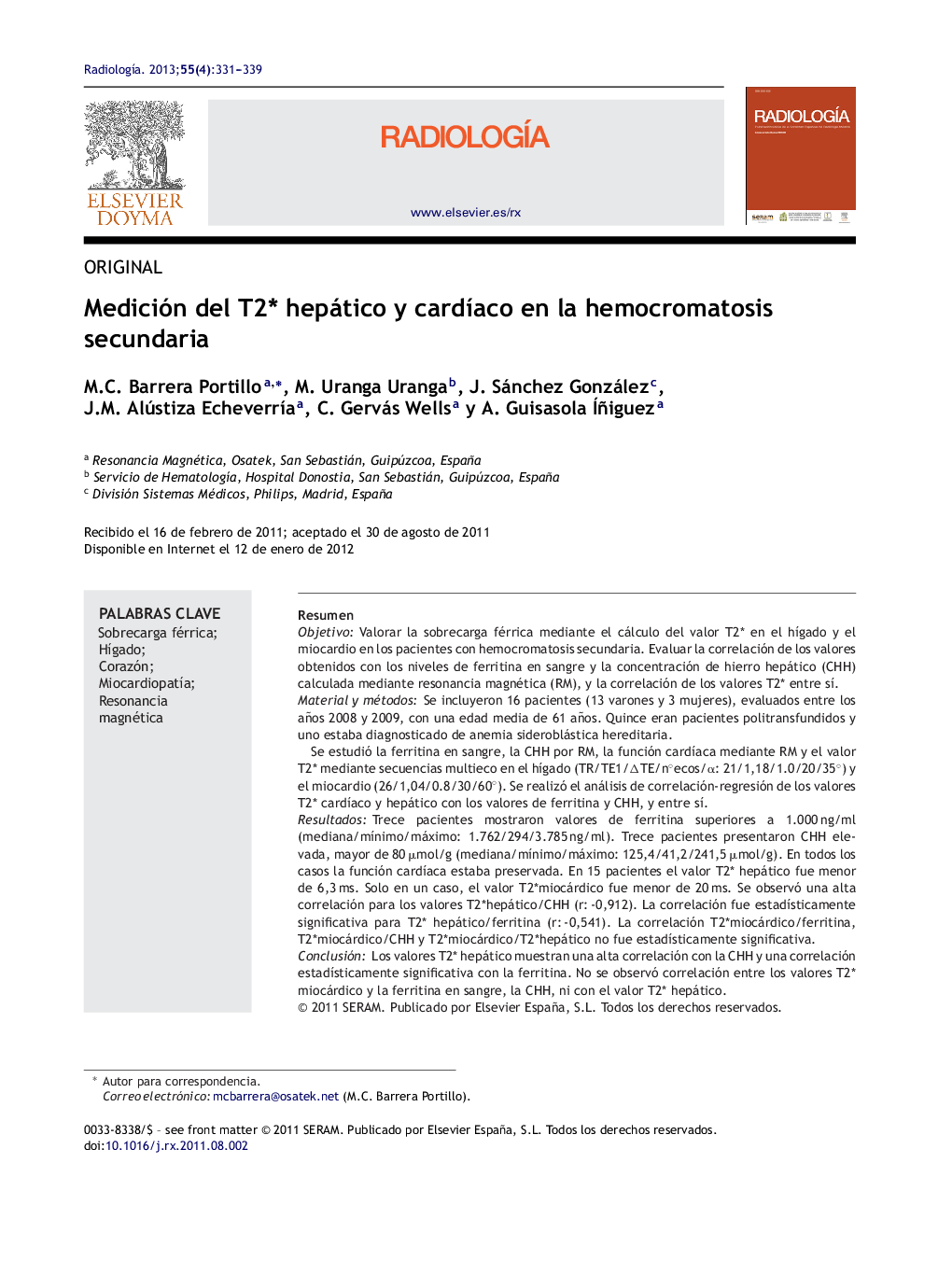| Article ID | Journal | Published Year | Pages | File Type |
|---|---|---|---|---|
| 4245505 | Radiología | 2013 | 9 Pages |
ResumenObjetivoValorar la sobrecarga férrica mediante el cálculo del valor T2* en el hígado y el miocardio en los pacientes con hemocromatosis secundaria. Evaluar la correlación de los valores obtenidos con los niveles de ferritina en sangre y la concentración de hierro hepático (CHH) calculada mediante resonancia magnética (RM), y la correlación de los valores T2* entre sí.Material y métodosSe incluyeron 16 pacientes (13 varones y 3 mujeres), evaluados entre los años 2008 y 2009, con una edad media de 61 años. Quince eran pacientes politransfundidos y uno estaba diagnosticado de anemia sideroblástica hereditaria.Se estudió la ferritina en sangre, la CHH por RM, la función cardíaca mediante RM y el valor T2* mediante secuencias multieco en el hígado (TR/TE1/ΔTE/n°ecos/α: 21/1,18/1.0/20/35°) y el miocardio (26/1,04/0.8/30/60°). Se realizó el análisis de correlación-regresión de los valores T2* cardíaco y hepático con los valores de ferritina y CHH, y entre sí.ResultadosTrece pacientes mostraron valores de ferritina superiores a 1.000 ng/ml (mediana/mínimo/máximo: 1.762/294/3.785 ng/ml). Trece pacientes presentaron CHH elevada, mayor de 80 μmol/g (mediana/mínimo/máximo: 125,4/41,2/241,5 μmol/g). En todos los casos la función cardíaca estaba preservada. En 15 pacientes el valor T2* hepático fue menor de 6,3 ms. Solo en un caso, el valor T2*miocárdico fue menor de 20 ms. Se observó una alta correlación para los valores T2*hepático/CHH (r: -0,912). La correlación fue estadísticamente significativa para T2* hepático/ferritina (r: -0,541). La correlación T2*miocárdico/ferritina, T2*miocárdico/CHH y T2*miocárdico/T2*hepático no fue estadísticamente significativa.ConclusiónLos valores T2* hepático muestran una alta correlación con la CHH y una correlación estadísticamente significativa con la ferritina. No se observó correlación entre los valores T2* miocárdico y la ferritina en sangre, la CHH, ni con el valor T2* hepático.
ObjectiveTo determine whether there is iron overload by calculating the T2* value in the liver and myocardium in patients with secondary haemochromatosis. To analyse the correlation of the values obtained with the iron levels in blood, with the liver iron concentration (LIC) calculated using magnetic resonance (MR) imaging, and the correlation between them.Material and methodsA total of 16 patients (13 males, 3 females), with a mean age of 61 years, were included and evaluated in the years 2008 and 2009. Fifteen of them had received multiple transfusions, and one was diagnosed with hereditary sideroblastic anaemia.The measurements included, blood ferritin, LIC by MRI, cardiac function using MRI and the T2* value by means of multi-echo sequences in the liver (TR/TE1/ΔTE/No of echos/α: 21/1,18/1.0/20/35°) and myocardium (26/1.04/0.8/30/60°). A correlation-regression analysis was performed by comparing the cardiac and liver T2* values with the ferritin, LIC and between each of them.ResultsA total of 13 patients had ferritin values greater than 1000 ng/ml (median/minimum/maximum: 1762/294/3785 ng/ml). An increased LIC greater than 80 μmol/g (median/minimum/maximum: 125.4/41.2/241.5 μmol/g) was observed in 13 patients. In all cases cardiac function was conserved, and in 15 cases the liver T2* value was less than 6.3 ms. The myocardium T2* value was less than 20 ms. in only one case. A high correlation was observed between the liver T2* values and the LIC (r: -0.912). The correlation was statistically significant between the liver T2* value and ferritin (r: -0.541). The correlations between myocardium T2* and ferritin, myocardium T2* and LIC, and myocardium T2* and liver T2* were not statistically significant.ConclusionsThe liver T2* showed a high correlation with LIC and a statistically significant correlation with ferritin. No association was observed between the myocardium T2* values and ferritin in blood, the LIC or the liver T2* value.
